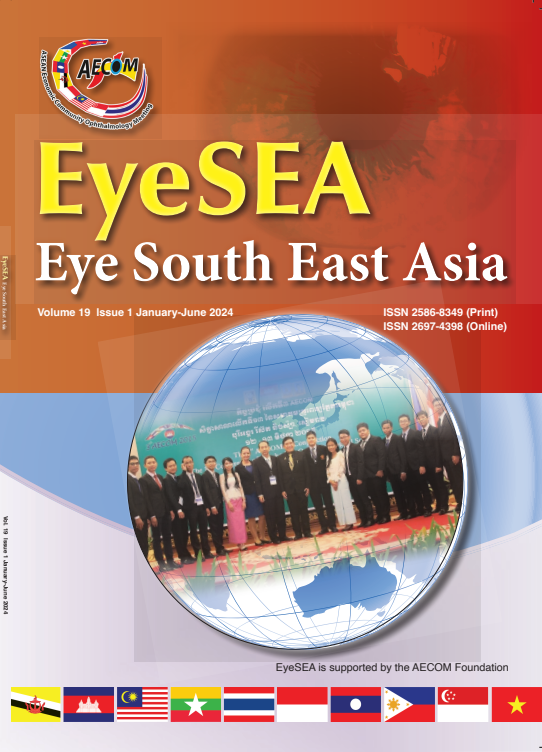Evaluating the Correlation between Pterygium SLIT2 Grading System and OCULUS Keratography
Main Article Content
Abstract
Background: Pterygium is known to contribute to ocular discomfort and dry eye symptoms. Traditionally, its measurement has been subjective and descriptive, relying on the attending physician’s assessment. The OCULUS K5M Keratograph offers an objective measurement, reducing bias and yielding more reproducible and reliable results. This study aims to evaluate ocular surface parameters using the OCULUS K5 Keratograph in eyes affected by unilateral pterygium and to explore the correlation with SLIT2 grading.
Method: A prospective study involved 67 participants with unilateral primary nasal pterygium. Ocular surface parameters were obtained using the OCULUS K5 keratograph and compared between unilateral pterygium eyes and their respective normal eyes. The relationship between SLIT2 pterygium grading and Keratograph parameters was also investigated.
Results: Pterygium eyes showed decreased tear break up time (TBUT) (6.76 ± 4.87 vs. 8.66 ± 5.13 seconds, p = 0.001) and increased bulbar redness (1.98 ± 0.56 vs. 1.42 ± 0.44, p < 0.0011) compared to non-pterygium eyes. High-grade SLIT2 pterygium injection was associated with shorter TBUT (low grade TBUT 5.05 ± 0.70 seconds, high grade TBUT 4.44 ± 3.38, p = 0.035). SLIT2 grading correlated significantly with bulbar redness, except for Stalker’s line.
Conclusion: Pterygium eyes displayed reduced TBUT and increased bulbar redness. High-grade pterygium was associated with shorter TBUT. Bulbar redness showed significant differences in SLIT2 grading, excluding Stalker’s line. No significant variations were observed in tear meniscus height and meibomian gland dysfunction grading.
Conflicts of interest: none
Article Details

This work is licensed under a Creative Commons Attribution-NonCommercial-NoDerivatives 4.0 International License.
References
Kampitak K, Leelawongtawun W. Precorneal tear film in pterygium eye. J Med Assoc Thai. 2014;97(5):536-9.
Linaburg T, Choi D, Bunya VY, MassaroGiordano M, Briceño CA. Systematic Review: Effects of Pterygium and Pingueculum on the Ocular Surface and Efficacy of Surgical Excision. Cornea. 2021;40(2):258-67.
Ye F, Zhou F, Xia Y, Zhu X, Wu Y, Huang Z. Evaluation of meibomian gland and tear film changes in patients with pterygium. Indian J Ophthalmol. 2017;65(3):233-7.
Ting DSJ, Liu YC, Patil M, Ji AJS, Fang XL, Tham YC, et al. Proposal and validation of a new grading system for pterygium (SLIT2). Br J Ophthalmol. 2021;105(7):921-4.
Portela RC, Fares NT, Machado LF, São Leão AF, de Freitas D, Paranhos A Jr, et al. Evaluation of Ocular Surface Disease in Patients With Glaucoma: Clinical Parameters, Self-report Assessment, and Keratograph Analysis. J Glaucoma. 2018;27(9):794-801.
Wanzeler ACV, Barbosa IAF, Duarte B, Barbosa EB, Borges DA, Alves M. Impact of pterygium on the ocular surface and meibomian glands. PLoS One. 2019;14(9):e0213956.
Wu S, Hong J, Tian L, Cui X, Sun X, Xu J. Assessment of Bulbar Redness with a Newly Developed Keratograph. Optom Vis Sci. 2015;92(8):892-9.
Arita R, Suehiro J, Haraguchi T, Shirakawa R, Tokoro H, Amano S. Objective image analysis of the meibomian gland area. Br J Ophthalmol. 2014;98(6):746-55.
Li N, Wang T, Wang R, Duan X. Tear Film Instability and Meibomian Gland Dysfunction Correlate with the Pterygium Size and Thickness Pre- and Postexcision in Patients with Pterygium. J Ophthalmol. 2019;2019:5935239.
Gaton D, Reznick L, Cunitzezki M, Weinberger D, Avisar I, Avisar R. Goblet cell distribution and epithelial cell morphology in pterygium. Harefuah. 2006;145(3):199-201, 245-6.
Li M, Zhang M, Lin Y, Xiao Q, Zhu X, Song S, et al. Tear function and goblet cell density after pterygium excision. Eye (Lond). 2007;21(2):224-8.
Vidas Pauk S, Petriček I, Jukić T, Popović-Suić S, Tomić M, Kalauz M, et al. NONINVASIVE TEAR FILM BREAK-UP TIME ASSESSMENT USING HANDHELD LIPID LAYER EXAMINATION INSTRUMENT. Acta Clin Croat. 2019;58(1):63-71.
Shahraki T, Arabi A, Feizi S. Pterygium: an update on pathophysiology, clinical features, and management. Ther Adv Ophthalmol. 2021;13:25158414211020152.
Hill JC, Maske R. Pathogenesis of pterygium. Eye. 1989;3(2):218-26.
Chatterjee S, Agrawal D. Short tear film breakup time-type of dry eye in India. Indian J Ophthalmol. 2021;69(12):3463-8.
Reda AM, Shaaban YMM, Saad El-Din SA. Histopathological Parameters in Pterygia and Significant Clinical Correlations. J Ophthalmic Vis Res. 2018;13(2):110-8.


